Consumer Behavior: Deconstructing the Myth of the Ethical Consumer
VerifiedAdded on 2023/04/22
|7
|2592
|384
Essay
AI Summary
This essay delves into the complexities of consumer behavior, challenging the notion of the 'ethical consumer' as a mythical figure. It examines various factors that influence consumer purchasing decisions, including marketing campaigns, economic conditions, personal preferences, cultural factors, and purchasing power. The essay also discusses the interplay between consumer behavior and marketing strategies, highlighting how companies leverage consumer insights to gain a competitive advantage. Furthermore, it explores different theories of consumer behavior, such as the EKB model and Hawkins Stern impulse buying theory, illustrating their practical applications in marketing. The analysis concludes that while ethical consumerism is growing, the majority of consumers are still primarily driven by rational factors, making the ethical consumer a somewhat idealized concept. Desklib provides a platform for students to access similar solved assignments and past papers for academic assistance.
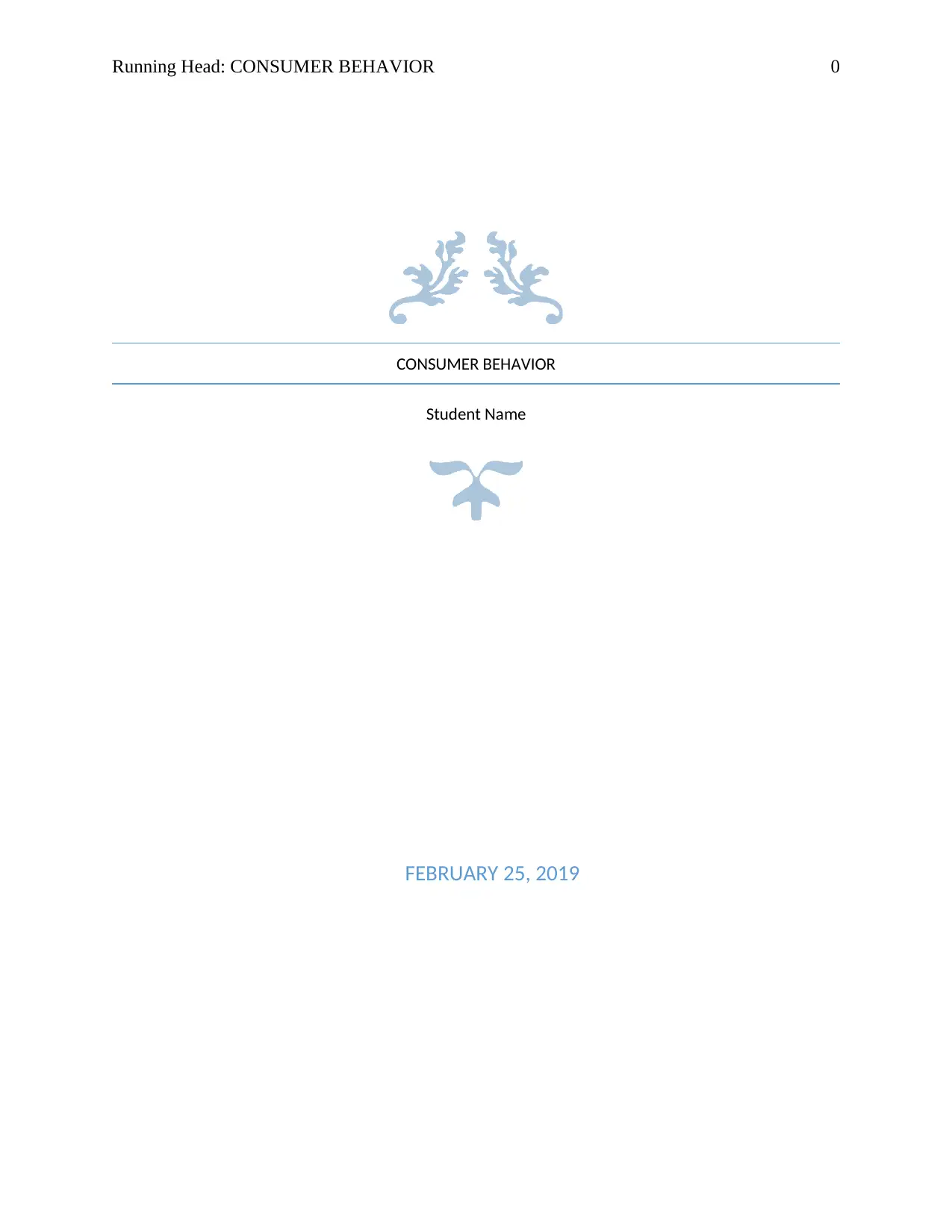
Running Head: CONSUMER BEHAVIOR 0
CONSUMER BEHAVIOR
Student Name
FEBRUARY 25, 2019
CONSUMER BEHAVIOR
Student Name
FEBRUARY 25, 2019
Paraphrase This Document
Need a fresh take? Get an instant paraphrase of this document with our AI Paraphraser

CONSUMER BEHAVIOR 1
Consumer Behaviour
A company’s major focus is over the consumer needs and requirements and how they respond to
the products and services the company would offer. This includes the study of a particular
consumer, or organization’s selecting, purchasing, and using behavior. Moreover, how they
would dispose of the ideas, services, and goods in order to satisfy the wants and needs of the
customer. Consumer behavior is referred to as the consumer’s actions in the marketplace and
their major objective for their actions taken. Marketers, for instance, are responsible for
identifying the major consumer causes to purchase specific services and goods, through which
the company could decide over the products, which would be required in the marketplace, and
how the way the company could best offer or present the product to the consumers (Soloman, et
al., 2013). Moreover, it has been observed that the ethical consumer is a mythical figure, which
the essay would discuss with examples for better understanding
Ethical consumer’s behavior is observed to depend over the cultural consideration of observation
according to one perspective and multidisciplinary in its nature according to another perspective.
Some of the relevant consumer’s model of ethical behavior are reflected over the theory of
planned behaviors given by Ajzen, which stated that the consumers purchase intention are
generated and motivated by moral norms, intrapersonal ethics, personal value systems, and some
more similar factors. There has been increased demand and interest of the consumer for ethical
goods and services, the reason being the overall consumer behavior consider ethical behavior for
governing to a large extent, although this is not followed by the demanded goods and services
actual purchase. The consumer behavior actually does not change with the intensity when
compared to the intended behavior (Stevens, et al., 2013).
There have been various researches over the way consumers consume, there are four metaphors
identified for consuming, these include consuming as integration, consuming as classification,
consuming as playing, and consuming as experience. These four metaphors depend on the level
of structure of action and purpose of the action. There are various factors that influence the
consumer behavior, five major factors include marketing campaigns, according to the researchers
conducted, and marketing plays an important role while influencing the consumer’s decision for
making a purchase of the particular product. The advertisement and creating customer perception
Consumer Behaviour
A company’s major focus is over the consumer needs and requirements and how they respond to
the products and services the company would offer. This includes the study of a particular
consumer, or organization’s selecting, purchasing, and using behavior. Moreover, how they
would dispose of the ideas, services, and goods in order to satisfy the wants and needs of the
customer. Consumer behavior is referred to as the consumer’s actions in the marketplace and
their major objective for their actions taken. Marketers, for instance, are responsible for
identifying the major consumer causes to purchase specific services and goods, through which
the company could decide over the products, which would be required in the marketplace, and
how the way the company could best offer or present the product to the consumers (Soloman, et
al., 2013). Moreover, it has been observed that the ethical consumer is a mythical figure, which
the essay would discuss with examples for better understanding
Ethical consumer’s behavior is observed to depend over the cultural consideration of observation
according to one perspective and multidisciplinary in its nature according to another perspective.
Some of the relevant consumer’s model of ethical behavior are reflected over the theory of
planned behaviors given by Ajzen, which stated that the consumers purchase intention are
generated and motivated by moral norms, intrapersonal ethics, personal value systems, and some
more similar factors. There has been increased demand and interest of the consumer for ethical
goods and services, the reason being the overall consumer behavior consider ethical behavior for
governing to a large extent, although this is not followed by the demanded goods and services
actual purchase. The consumer behavior actually does not change with the intensity when
compared to the intended behavior (Stevens, et al., 2013).
There have been various researches over the way consumers consume, there are four metaphors
identified for consuming, these include consuming as integration, consuming as classification,
consuming as playing, and consuming as experience. These four metaphors depend on the level
of structure of action and purpose of the action. There are various factors that influence the
consumer behavior, five major factors include marketing campaigns, according to the researchers
conducted, and marketing plays an important role while influencing the consumer’s decision for
making a purchase of the particular product. The advertisement and creating customer perception
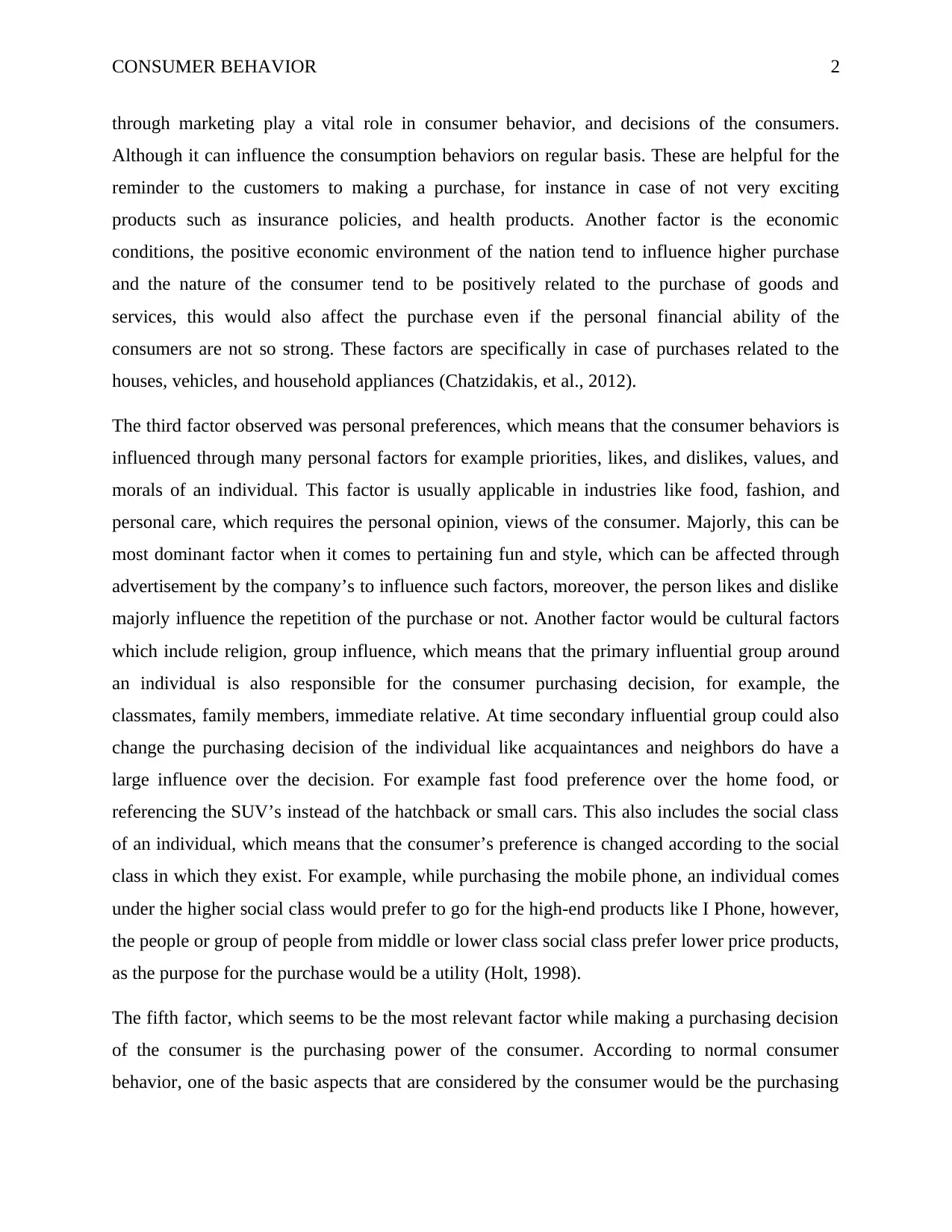
CONSUMER BEHAVIOR 2
through marketing play a vital role in consumer behavior, and decisions of the consumers.
Although it can influence the consumption behaviors on regular basis. These are helpful for the
reminder to the customers to making a purchase, for instance in case of not very exciting
products such as insurance policies, and health products. Another factor is the economic
conditions, the positive economic environment of the nation tend to influence higher purchase
and the nature of the consumer tend to be positively related to the purchase of goods and
services, this would also affect the purchase even if the personal financial ability of the
consumers are not so strong. These factors are specifically in case of purchases related to the
houses, vehicles, and household appliances (Chatzidakis, et al., 2012).
The third factor observed was personal preferences, which means that the consumer behaviors is
influenced through many personal factors for example priorities, likes, and dislikes, values, and
morals of an individual. This factor is usually applicable in industries like food, fashion, and
personal care, which requires the personal opinion, views of the consumer. Majorly, this can be
most dominant factor when it comes to pertaining fun and style, which can be affected through
advertisement by the company’s to influence such factors, moreover, the person likes and dislike
majorly influence the repetition of the purchase or not. Another factor would be cultural factors
which include religion, group influence, which means that the primary influential group around
an individual is also responsible for the consumer purchasing decision, for example, the
classmates, family members, immediate relative. At time secondary influential group could also
change the purchasing decision of the individual like acquaintances and neighbors do have a
large influence over the decision. For example fast food preference over the home food, or
referencing the SUV’s instead of the hatchback or small cars. This also includes the social class
of an individual, which means that the consumer’s preference is changed according to the social
class in which they exist. For example, while purchasing the mobile phone, an individual comes
under the higher social class would prefer to go for the high-end products like I Phone, however,
the people or group of people from middle or lower class social class prefer lower price products,
as the purpose for the purchase would be a utility (Holt, 1998).
The fifth factor, which seems to be the most relevant factor while making a purchasing decision
of the consumer is the purchasing power of the consumer. According to normal consumer
behavior, one of the basic aspects that are considered by the consumer would be the purchasing
through marketing play a vital role in consumer behavior, and decisions of the consumers.
Although it can influence the consumption behaviors on regular basis. These are helpful for the
reminder to the customers to making a purchase, for instance in case of not very exciting
products such as insurance policies, and health products. Another factor is the economic
conditions, the positive economic environment of the nation tend to influence higher purchase
and the nature of the consumer tend to be positively related to the purchase of goods and
services, this would also affect the purchase even if the personal financial ability of the
consumers are not so strong. These factors are specifically in case of purchases related to the
houses, vehicles, and household appliances (Chatzidakis, et al., 2012).
The third factor observed was personal preferences, which means that the consumer behaviors is
influenced through many personal factors for example priorities, likes, and dislikes, values, and
morals of an individual. This factor is usually applicable in industries like food, fashion, and
personal care, which requires the personal opinion, views of the consumer. Majorly, this can be
most dominant factor when it comes to pertaining fun and style, which can be affected through
advertisement by the company’s to influence such factors, moreover, the person likes and dislike
majorly influence the repetition of the purchase or not. Another factor would be cultural factors
which include religion, group influence, which means that the primary influential group around
an individual is also responsible for the consumer purchasing decision, for example, the
classmates, family members, immediate relative. At time secondary influential group could also
change the purchasing decision of the individual like acquaintances and neighbors do have a
large influence over the decision. For example fast food preference over the home food, or
referencing the SUV’s instead of the hatchback or small cars. This also includes the social class
of an individual, which means that the consumer’s preference is changed according to the social
class in which they exist. For example, while purchasing the mobile phone, an individual comes
under the higher social class would prefer to go for the high-end products like I Phone, however,
the people or group of people from middle or lower class social class prefer lower price products,
as the purpose for the purchase would be a utility (Holt, 1998).
The fifth factor, which seems to be the most relevant factor while making a purchasing decision
of the consumer is the purchasing power of the consumer. According to normal consumer
behavior, one of the basic aspects that are considered by the consumer would be the purchasing
⊘ This is a preview!⊘
Do you want full access?
Subscribe today to unlock all pages.

Trusted by 1+ million students worldwide

CONSUMER BEHAVIOR 3
capacity before going for any product or service to be availed. The product of the company could
be up to the mark when it comes to the quality, but it could unable to meet the purchasing ability
of the consumer, which could lead to the lower sale of the product. For the marketers, this factor
could be considered while segmenting the customers according to their income group in order to
increase the sale of the product while targeting the correct group of people in the market. There
have been researches made, which include the emerging markets as the new middle-class
consumers, considering this factor (Dahl & Solomon, 2014).
The marketing concept plays a vital role in consumer behavior and vice versa, that is the
consumer behavior is largely responsible for the development of marketing strategies of the
company. The company could have the opportunity to gain a competitive advantage in the
industry, through appropriate consumer behaviors knowledge. Some of the consumer behavior
principles that could be useful in major areas of marketing. These include analyzing the market
opportunity, through the consumer behavior, the marketers can identify the needs and wants that
are seems to be unfulfilled, this is conducted through trends scanning and conditions that are
influencing the market area, customer income levels, and customer’s lifestyles. For example, the
marketers through studying consumer behavior find out that in some nations, say India, the
customers do not prefer the shampoos which are above 60 rupees, therefore, the companies tend
to see this as an opportunity and bring change to its marketing strategy through packaging of eth
product through offering the smaller packed products that are in sachet packaging to target such
customers. Afterward, it was observed that the people were ready to spend two or three rupees
for each sachet instead of the bottle packaging. The influence of consumer behavior over the
marketing strategies could be included through some of the examples, for instance nestle in
India, introduced Maggi noodle with capsicum and masala flavours, but considering the culture
and regions different in food culture and taste, the company included Sāmbhar, data, oats, soupy
noodles and various other flavors in the noodles (Ang & Rusli, 2018).
The aspect of consumer behavior could be illustrated through some of the theories of consumer
behavior. For instance, the EKB model, that is Engel, Kollet, Backwell model provided the five-
step process that is been used by the consumer for making a purchase. According to this model,
there are two available periods for the marketers that is the initial stage, which is the information
stage to provide them the information of the product in a more presentable way, and another
capacity before going for any product or service to be availed. The product of the company could
be up to the mark when it comes to the quality, but it could unable to meet the purchasing ability
of the consumer, which could lead to the lower sale of the product. For the marketers, this factor
could be considered while segmenting the customers according to their income group in order to
increase the sale of the product while targeting the correct group of people in the market. There
have been researches made, which include the emerging markets as the new middle-class
consumers, considering this factor (Dahl & Solomon, 2014).
The marketing concept plays a vital role in consumer behavior and vice versa, that is the
consumer behavior is largely responsible for the development of marketing strategies of the
company. The company could have the opportunity to gain a competitive advantage in the
industry, through appropriate consumer behaviors knowledge. Some of the consumer behavior
principles that could be useful in major areas of marketing. These include analyzing the market
opportunity, through the consumer behavior, the marketers can identify the needs and wants that
are seems to be unfulfilled, this is conducted through trends scanning and conditions that are
influencing the market area, customer income levels, and customer’s lifestyles. For example, the
marketers through studying consumer behavior find out that in some nations, say India, the
customers do not prefer the shampoos which are above 60 rupees, therefore, the companies tend
to see this as an opportunity and bring change to its marketing strategy through packaging of eth
product through offering the smaller packed products that are in sachet packaging to target such
customers. Afterward, it was observed that the people were ready to spend two or three rupees
for each sachet instead of the bottle packaging. The influence of consumer behavior over the
marketing strategies could be included through some of the examples, for instance nestle in
India, introduced Maggi noodle with capsicum and masala flavours, but considering the culture
and regions different in food culture and taste, the company included Sāmbhar, data, oats, soupy
noodles and various other flavors in the noodles (Ang & Rusli, 2018).
The aspect of consumer behavior could be illustrated through some of the theories of consumer
behavior. For instance, the EKB model, that is Engel, Kollet, Backwell model provided the five-
step process that is been used by the consumer for making a purchase. According to this model,
there are two available periods for the marketers that is the initial stage, which is the information
stage to provide them the information of the product in a more presentable way, and another
Paraphrase This Document
Need a fresh take? Get an instant paraphrase of this document with our AI Paraphraser
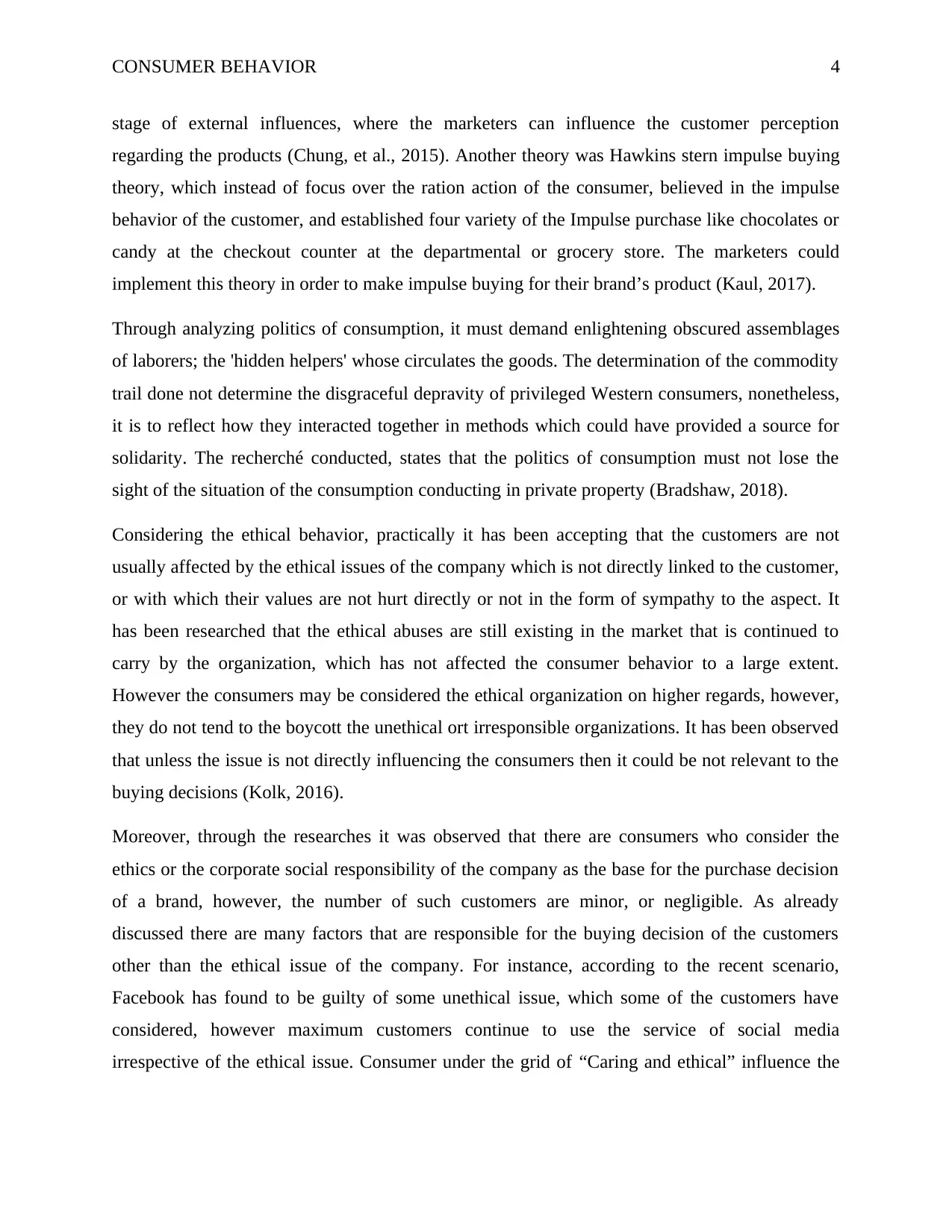
CONSUMER BEHAVIOR 4
stage of external influences, where the marketers can influence the customer perception
regarding the products (Chung, et al., 2015). Another theory was Hawkins stern impulse buying
theory, which instead of focus over the ration action of the consumer, believed in the impulse
behavior of the customer, and established four variety of the Impulse purchase like chocolates or
candy at the checkout counter at the departmental or grocery store. The marketers could
implement this theory in order to make impulse buying for their brand’s product (Kaul, 2017).
Through analyzing politics of consumption, it must demand enlightening obscured assemblages
of laborers; the 'hidden helpers' whose circulates the goods. The determination of the commodity
trail done not determine the disgraceful depravity of privileged Western consumers, nonetheless,
it is to reflect how they interacted together in methods which could have provided a source for
solidarity. The recherché conducted, states that the politics of consumption must not lose the
sight of the situation of the consumption conducting in private property (Bradshaw, 2018).
Considering the ethical behavior, practically it has been accepting that the customers are not
usually affected by the ethical issues of the company which is not directly linked to the customer,
or with which their values are not hurt directly or not in the form of sympathy to the aspect. It
has been researched that the ethical abuses are still existing in the market that is continued to
carry by the organization, which has not affected the consumer behavior to a large extent.
However the consumers may be considered the ethical organization on higher regards, however,
they do not tend to the boycott the unethical ort irresponsible organizations. It has been observed
that unless the issue is not directly influencing the consumers then it could be not relevant to the
buying decisions (Kolk, 2016).
Moreover, through the researches it was observed that there are consumers who consider the
ethics or the corporate social responsibility of the company as the base for the purchase decision
of a brand, however, the number of such customers are minor, or negligible. As already
discussed there are many factors that are responsible for the buying decision of the customers
other than the ethical issue of the company. For instance, according to the recent scenario,
Facebook has found to be guilty of some unethical issue, which some of the customers have
considered, however maximum customers continue to use the service of social media
irrespective of the ethical issue. Consumer under the grid of “Caring and ethical” influence the
stage of external influences, where the marketers can influence the customer perception
regarding the products (Chung, et al., 2015). Another theory was Hawkins stern impulse buying
theory, which instead of focus over the ration action of the consumer, believed in the impulse
behavior of the customer, and established four variety of the Impulse purchase like chocolates or
candy at the checkout counter at the departmental or grocery store. The marketers could
implement this theory in order to make impulse buying for their brand’s product (Kaul, 2017).
Through analyzing politics of consumption, it must demand enlightening obscured assemblages
of laborers; the 'hidden helpers' whose circulates the goods. The determination of the commodity
trail done not determine the disgraceful depravity of privileged Western consumers, nonetheless,
it is to reflect how they interacted together in methods which could have provided a source for
solidarity. The recherché conducted, states that the politics of consumption must not lose the
sight of the situation of the consumption conducting in private property (Bradshaw, 2018).
Considering the ethical behavior, practically it has been accepting that the customers are not
usually affected by the ethical issues of the company which is not directly linked to the customer,
or with which their values are not hurt directly or not in the form of sympathy to the aspect. It
has been researched that the ethical abuses are still existing in the market that is continued to
carry by the organization, which has not affected the consumer behavior to a large extent.
However the consumers may be considered the ethical organization on higher regards, however,
they do not tend to the boycott the unethical ort irresponsible organizations. It has been observed
that unless the issue is not directly influencing the consumers then it could be not relevant to the
buying decisions (Kolk, 2016).
Moreover, through the researches it was observed that there are consumers who consider the
ethics or the corporate social responsibility of the company as the base for the purchase decision
of a brand, however, the number of such customers are minor, or negligible. As already
discussed there are many factors that are responsible for the buying decision of the customers
other than the ethical issue of the company. For instance, according to the recent scenario,
Facebook has found to be guilty of some unethical issue, which some of the customers have
considered, however maximum customers continue to use the service of social media
irrespective of the ethical issue. Consumer under the grid of “Caring and ethical” influence the
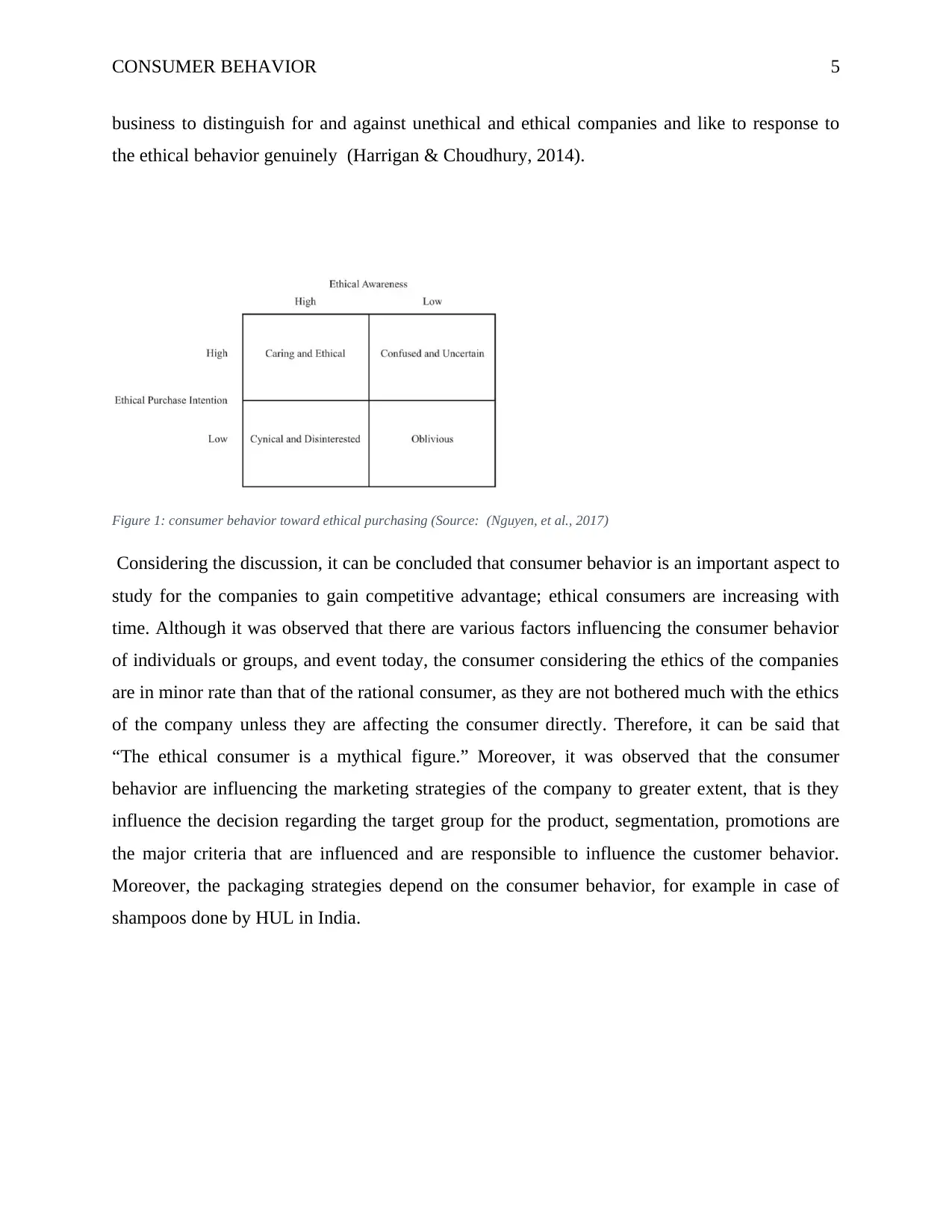
CONSUMER BEHAVIOR 5
business to distinguish for and against unethical and ethical companies and like to response to
the ethical behavior genuinely (Harrigan & Choudhury, 2014).
Figure 1: consumer behavior toward ethical purchasing (Source: (Nguyen, et al., 2017)
Considering the discussion, it can be concluded that consumer behavior is an important aspect to
study for the companies to gain competitive advantage; ethical consumers are increasing with
time. Although it was observed that there are various factors influencing the consumer behavior
of individuals or groups, and event today, the consumer considering the ethics of the companies
are in minor rate than that of the rational consumer, as they are not bothered much with the ethics
of the company unless they are affecting the consumer directly. Therefore, it can be said that
“The ethical consumer is a mythical figure.” Moreover, it was observed that the consumer
behavior are influencing the marketing strategies of the company to greater extent, that is they
influence the decision regarding the target group for the product, segmentation, promotions are
the major criteria that are influenced and are responsible to influence the customer behavior.
Moreover, the packaging strategies depend on the consumer behavior, for example in case of
shampoos done by HUL in India.
business to distinguish for and against unethical and ethical companies and like to response to
the ethical behavior genuinely (Harrigan & Choudhury, 2014).
Figure 1: consumer behavior toward ethical purchasing (Source: (Nguyen, et al., 2017)
Considering the discussion, it can be concluded that consumer behavior is an important aspect to
study for the companies to gain competitive advantage; ethical consumers are increasing with
time. Although it was observed that there are various factors influencing the consumer behavior
of individuals or groups, and event today, the consumer considering the ethics of the companies
are in minor rate than that of the rational consumer, as they are not bothered much with the ethics
of the company unless they are affecting the consumer directly. Therefore, it can be said that
“The ethical consumer is a mythical figure.” Moreover, it was observed that the consumer
behavior are influencing the marketing strategies of the company to greater extent, that is they
influence the decision regarding the target group for the product, segmentation, promotions are
the major criteria that are influenced and are responsible to influence the customer behavior.
Moreover, the packaging strategies depend on the consumer behavior, for example in case of
shampoos done by HUL in India.
⊘ This is a preview!⊘
Do you want full access?
Subscribe today to unlock all pages.

Trusted by 1+ million students worldwide
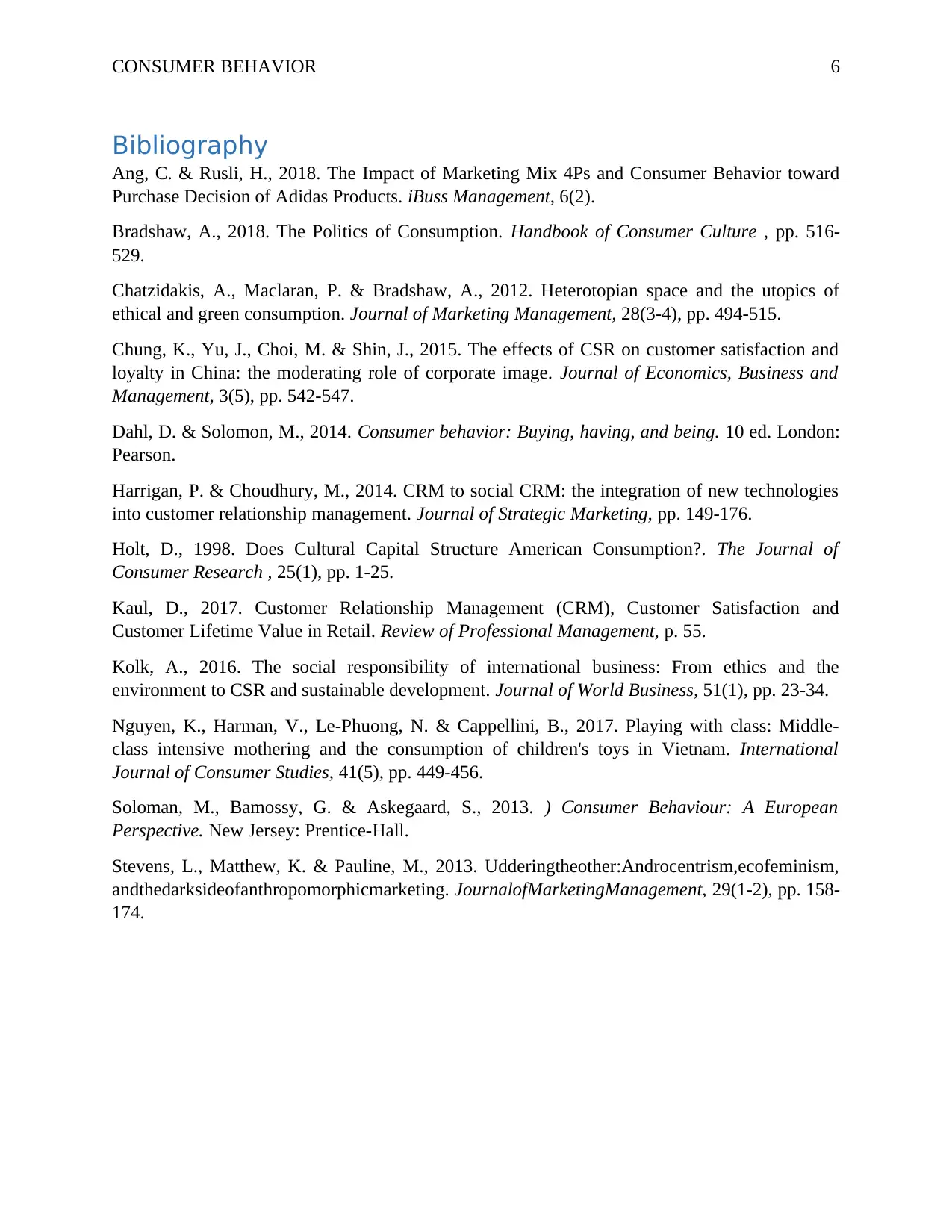
CONSUMER BEHAVIOR 6
Bibliography
Ang, C. & Rusli, H., 2018. The Impact of Marketing Mix 4Ps and Consumer Behavior toward
Purchase Decision of Adidas Products. iBuss Management, 6(2).
Bradshaw, A., 2018. The Politics of Consumption. Handbook of Consumer Culture , pp. 516-
529.
Chatzidakis, A., Maclaran, P. & Bradshaw, A., 2012. Heterotopian space and the utopics of
ethical and green consumption. Journal of Marketing Management, 28(3-4), pp. 494-515.
Chung, K., Yu, J., Choi, M. & Shin, J., 2015. The effects of CSR on customer satisfaction and
loyalty in China: the moderating role of corporate image. Journal of Economics, Business and
Management, 3(5), pp. 542-547.
Dahl, D. & Solomon, M., 2014. Consumer behavior: Buying, having, and being. 10 ed. London:
Pearson.
Harrigan, P. & Choudhury, M., 2014. CRM to social CRM: the integration of new technologies
into customer relationship management. Journal of Strategic Marketing, pp. 149-176.
Holt, D., 1998. Does Cultural Capital Structure American Consumption?. The Journal of
Consumer Research , 25(1), pp. 1-25.
Kaul, D., 2017. Customer Relationship Management (CRM), Customer Satisfaction and
Customer Lifetime Value in Retail. Review of Professional Management, p. 55.
Kolk, A., 2016. The social responsibility of international business: From ethics and the
environment to CSR and sustainable development. Journal of World Business, 51(1), pp. 23-34.
Nguyen, K., Harman, V., Le-Phuong, N. & Cappellini, B., 2017. Playing with class: Middle‐
class intensive mothering and the consumption of children's toys in Vietnam. International
Journal of Consumer Studies, 41(5), pp. 449-456.
Soloman, M., Bamossy, G. & Askegaard, S., 2013. ) Consumer Behaviour: A European
Perspective. New Jersey: Prentice-Hall.
Stevens, L., Matthew, K. & Pauline, M., 2013. Udderingtheother:Androcentrism,ecofeminism,
andthedarksideofanthropomorphicmarketing. JournalofMarketingManagement, 29(1-2), pp. 158-
174.
Bibliography
Ang, C. & Rusli, H., 2018. The Impact of Marketing Mix 4Ps and Consumer Behavior toward
Purchase Decision of Adidas Products. iBuss Management, 6(2).
Bradshaw, A., 2018. The Politics of Consumption. Handbook of Consumer Culture , pp. 516-
529.
Chatzidakis, A., Maclaran, P. & Bradshaw, A., 2012. Heterotopian space and the utopics of
ethical and green consumption. Journal of Marketing Management, 28(3-4), pp. 494-515.
Chung, K., Yu, J., Choi, M. & Shin, J., 2015. The effects of CSR on customer satisfaction and
loyalty in China: the moderating role of corporate image. Journal of Economics, Business and
Management, 3(5), pp. 542-547.
Dahl, D. & Solomon, M., 2014. Consumer behavior: Buying, having, and being. 10 ed. London:
Pearson.
Harrigan, P. & Choudhury, M., 2014. CRM to social CRM: the integration of new technologies
into customer relationship management. Journal of Strategic Marketing, pp. 149-176.
Holt, D., 1998. Does Cultural Capital Structure American Consumption?. The Journal of
Consumer Research , 25(1), pp. 1-25.
Kaul, D., 2017. Customer Relationship Management (CRM), Customer Satisfaction and
Customer Lifetime Value in Retail. Review of Professional Management, p. 55.
Kolk, A., 2016. The social responsibility of international business: From ethics and the
environment to CSR and sustainable development. Journal of World Business, 51(1), pp. 23-34.
Nguyen, K., Harman, V., Le-Phuong, N. & Cappellini, B., 2017. Playing with class: Middle‐
class intensive mothering and the consumption of children's toys in Vietnam. International
Journal of Consumer Studies, 41(5), pp. 449-456.
Soloman, M., Bamossy, G. & Askegaard, S., 2013. ) Consumer Behaviour: A European
Perspective. New Jersey: Prentice-Hall.
Stevens, L., Matthew, K. & Pauline, M., 2013. Udderingtheother:Androcentrism,ecofeminism,
andthedarksideofanthropomorphicmarketing. JournalofMarketingManagement, 29(1-2), pp. 158-
174.
1 out of 7
Related Documents
Your All-in-One AI-Powered Toolkit for Academic Success.
+13062052269
info@desklib.com
Available 24*7 on WhatsApp / Email
![[object Object]](/_next/static/media/star-bottom.7253800d.svg)
Unlock your academic potential
Copyright © 2020–2025 A2Z Services. All Rights Reserved. Developed and managed by ZUCOL.





